Automotive photographer Easton Chang has developed his unique shooting style in the pressure cooker environment of car marketing, but it has served him well, he tells Marc Gafen.
A career as a professional photographer wasn't always on the cards for Easton Chang. After high school he started a degree in software engineering at the University of Newcastle. His initial interest in photography came about through his true passion at the time – cars! Chang bought his first camera in 2002 – a Canon PowerShot S45 – for the express purpose of shooting pictures of his "beloved" Honda Integra Type R.
If someone had asked him then if he believed he would be where he currently is in the world of professional automotive photography, he says there's no way he could have dreamt of it. But these days he travels all over the world on commissioned assignments to destinations including the US, China, New Zealand, France, Spain and London, as well as all over Australia. Some of his bigger clients include Cadillac, Jaguar, Mazda, General Motors, Ford Lexus, Audi and Porsche.
As his interest in the craft grew Chang invested in a Canon 300D SLR and became heavily involved shooting cars in his local community. This new love developed and grew. With his appetite whet, a year later Chang began shooting professionally, on a part-time basis, while still studying, deciding to complete his studies just in case he needed "something to fall back on".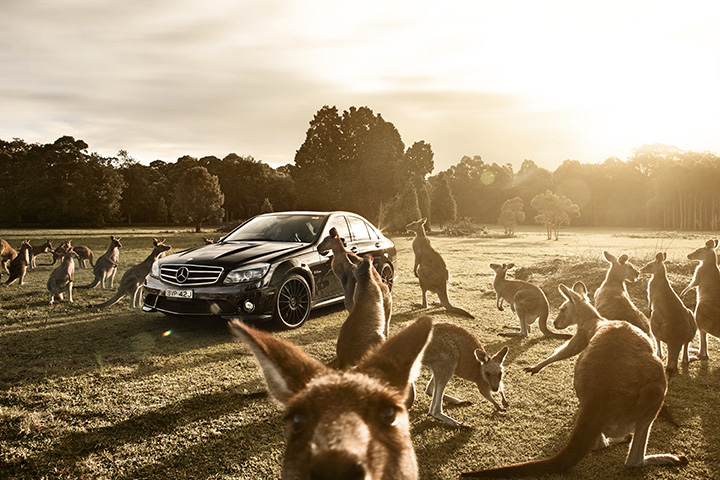
Press shot for Mercedes Benz, shot on location with wild kangaroos. The roos were lured by an assistant with food. A second shot was taken to brush the assistant out of the shot. The kangaroos were actually looking at the assistant for food, not the car. Canon EOS 5D Mark III, 24-70 F2.8. F11 1/125 ISO 800.
"Cars have always been my first passion," Chang says. "They're the reason I became a professional photographer in the first place, and I'm pretty certain that I'll specialise in them for the rest of my career."
After completing his degree Chang had the option of heading down the IT path, a choice that offered job security and well-paid positions. However, he decided to follow his heart and his passion and try his hand at photography, despite a number of reservations as to whether he'd actually be able to sustain himself financially.
Initially, Chang invested his time and effort shooting for a number of editorial clients. While his first image published in a magazine was for "Photo of the month", his first commission was for Speed magazine. It was easier for him to build his career and profile shooting assignments for magazines because advertising work required much more experience in production. He spent the first five years of his career focusing almost solely on editorial work. These assignments afforded him far greater creative input and direction on the look and feel of what he was producing, and more importantly, allowed him to really hone his skills, learning about the intricacies of lighting cars in various settings and environments and to become familiar with all aspects of the best gear to use, as well as retouching and post-production techniques.
While these days Chang shoots more advertising than editorial work, he says he's always happy to take on the odd magazine shoot because he feels this keeps him "sharp" and it's a purer form of photography compared to the production-based advertising work. "To this day," he says, "I still use my editorial assignments to continue developing my work."
Shot in a studio for Motor magazine. Multiple exposures stitched together. Canon EOS 5D Mark III, 24-70mm f2.8 lens, 25s @ f/16, ISO 100.
A foot in the door
Anyone in the early stages of their career as a professional photographer would no doubt relate to Chang's experiences. Contrary to popular belief, getting a career off the ground takes considerable perseverance, focus and grit.
"In the early 2000s I tried contacting nearly every car magazine in Australia with my portfolio," he recalls. "After nine months of empty promises of work, I almost gave up until I got my first real opportunity when I was commissioned by Speed magazine."
The fact that the title was part of the ACP stable of magazines led Chang to opportunities to shoot for a number of sister publications, and this provided a welcome boost, both financially and creatively.
It's almost impossible to develop as a photographer working in a vacuum, and many photographers benefit tremendously from the advice, wisdom and experience of more established shooters. Chang has benefited from the input of older, more experienced professionals along the way. In his case, however, these people were not other photographers, but art directors, editors and producers.
He says that having people such as these with whom you can be completely transparent helped him grow in this tough industry. Much of the learning was focused around the business and marketing of one's work so he could get noticed.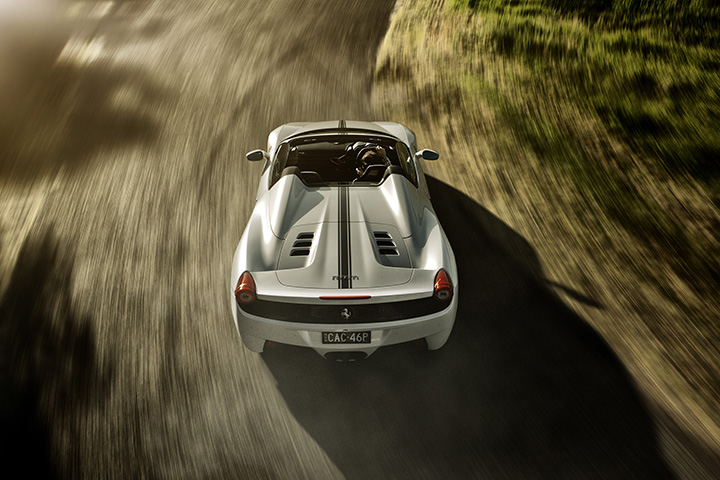
Ferrari 458 Spyder shot for caradvice.com.au on location near Singleton, NSW. The image was shot static then retouched into an action shot. Canon EOS 5D Mark III, 24-70mm f/2.8. f/8 @ 1/250s, ISO 250.
Gear and equipment
Chang's approach to his photographic kit and the gear he relies on varies considerably, depending on whether he's shooting for editorial or advertising clients. For the former, he relies on a Canon EOS 5D Mk II and Mk III with an array of lenses including the Canon 17-40mm f/4, a 24-70mm f/2.8 and 70-200mm f/2.8. His favourite, however, is the 24-70mm, which he says he uses for the vast majority of his work because of its versatility for car photography.
His lighting kit includes four Bowens 400W strobes which he couples with a variety of self-described "weird" light modifiers for experimentation and effects. All of this goes into Pelican cases, which Chang says he finds the most reliable. And when you travel as much as Chang does, this sort of peace of mind – that his equipment is safe and secure – is crucial. On advertising assignments Chang hires everything, allowing his producer to handle much of that side of things so he can focus his energy instead on the client, the brief and what he's going to deliver. But typically he will use Hasselblad or Phase One digital backs. While on the go Chang has found battery-powered LED lights to be invaluable. In numerous situations these lights can be used in a multitude of ways, especially since in many situations where static shots are being done, flash lighting is not required to freeze movement.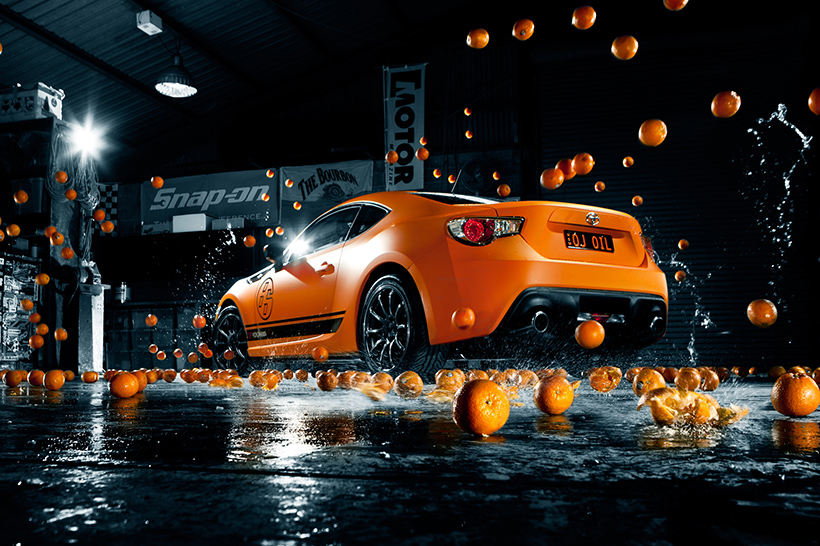
Late-night shoot in a shed for Yokohama Australia. Chang and his team spent a few hours setting up the right lighting (anticipating where the oranges would be), then used around 20 boxes of oranges through the night. Two Speedlites and three studio strobes were used. Canon EOS 5D Mark III, 24-70mm f/2.8 lens, 1/30s @ f/10, ISO 100.
Photographic style
Any photographer "worth his salt" is almost always heavily focused on their photographic style, and constantly evolving it. Asked about his style, Chang thinks that what sets his apart from others in the industry is that he tries hard to avoid producing images which are overly sleek or 'perfect-looking'. In the age of CGI (computer-generated imagery), which is always encroaching on the realm of professional car photography, this approach makes sense.
"I always try to give my work a bit more of a raw look and feel, and even when special effects are required, I always aim at shooting all the elements in-camera," Chang says. "In a world full of the super-perfect, nearing on unrealistic car imagery, I also think that sometimes it's important to have that grounded, raw look in advertising as well."
Chang says his workflow relies heavily on detailed and intricate Photoshop work for everything he produces, with obviously some images requiring more attention than others. "Post production is incredibly important in car photography," he says. "Because cars don't move, blending multiple exposures on a locked-down tripod is almost a given when it comes to high-end car photography."
With a style that's easy to recognise, some of Chang's hallmark images include an ad for Yokohama, a shot of a 1966 Ford Mustang in a workshop, a Porsche 911 with a flaming background and a redline tachometer shot which he believes is probably the most-used (or stolen!) automotive-related photo in the world – a shot which he first did in 2003 with his Powershot S45. Many of these shots he says have spawned copycats around the world. Given how prolific his following is, this isn't hard to believe. His Facebook page (www.facebook.com/eastonchangphotography) currently has an impressive number of fans, totalling over 500,000!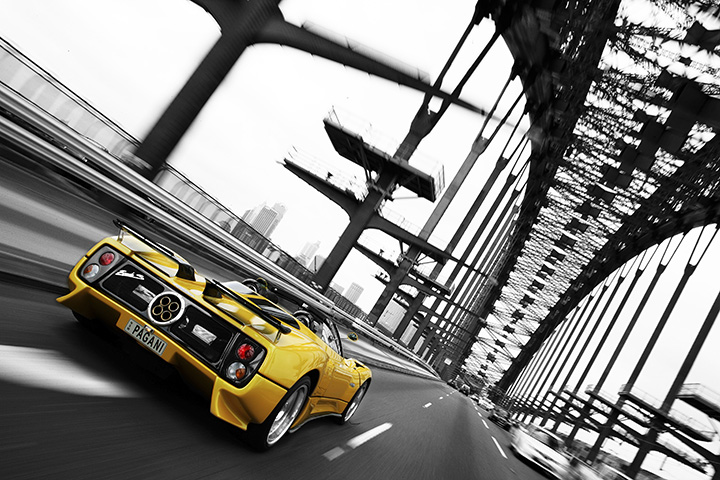
Shot for Motor magazine, the only Pagani Zonda in Australia. Shot from a ute as is, desaturated the background for effect. Canon EOS 1Ds Mark II, 24-70 F2.8, F22 1/20 ISO 100
Philosophical approach
Like other areas of photography, great car imagery relies heavily on location, lighting and composition, but Chang adds that all these elements have to tie in with the "personality" and style of the car if you're hoping to shoot an amazing automotive image. When it comes to his photographic philosophy, Chang's images are all about rawness – real and raw elements and capturing everything "real" in camera. This approach lends itself particularly well to his favourite subject matter – exotic super cars shot in dark, grungy locations.
"They're the pinnacle of what I'm passionate about both as a professional, and when I was a hobbyist," he says. To get to where he now finds himself, Chang has had to work incredibly hard and the work continues to be demanding and challenging. On one editorial assignment Chang recalls having to work for 22 hours straight, without time for a drink or even a snack, while on another shoot with Lamborghini Aventador, Chang had just five minutes with the car.
Not one to be confined to shooting cars in studios alone, much of Chang's work is shot on location and he's certainly found himself in some rather unusual situations to get a shot! Just some of these include shooting from the top of the Sydney Harbour Bridge ("an OH&S hurdle like you wouldn't believe"), clinging to the roof on an Audi R8, using suction cups while shooting back (which he describes as his "ultimate experience in automotive heaven"), hiding in the back tray of a ute and then popping up on the Sydney Harbour Bridge to shoot the only Pagani Zonda in Australia and shooting a park full of kangaroos surrounding a Mercedes C63 AMG.
Other than the Zonda, Chang says that the most expensive car he's ever photographed, and probably his favourite so far, is the Koenigsegg CCX, which has an asking price of $2.2 million in Australia.
Chang draws inspiration from many sources. One photographer who has been particularly inspirational for him is Ansel Adams, because of the amazing images he created without the current fancy tools and techniques, and his pioneering of techniques which are still used today in the digital darkroom. Travel is also a significant source of inspiration and Chang takes one to two months off each year to travel to new destinations around the world.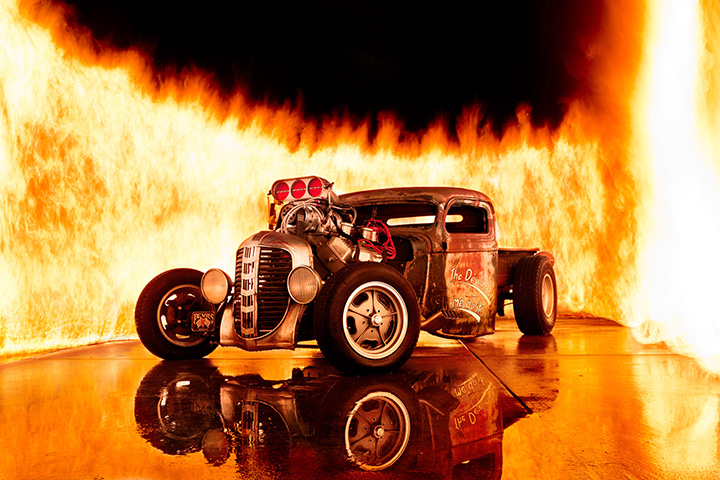
Late night shoot for Street Machine magazine cover. Chang set up a wall of fire and used it entirely to light the shot. No flash. Canon EOS 5D Mark III, 24-70mm f/2.8 lens, 30s @ f/16.
Words of wisdom
For anyone seriously considering a career as a professional photographer Chang offers some sage advice.
"Examine the work of photographers whose styles you like, but focus on developing your own signature style. Having a great, unique style is what gets you noticed, not copying one."
He believes that photographers are only as good as their weakest link, and broadly speaking, photographers have skills which fall into two categories – the technical and the creative – but being proficient in both is crucial. The creative aspect covers envisioning the shot and being clear in your mind about the kind of result you're hoping to achieve, while the technical is having the ability to realise and implement what's necessary to achieve your creative goals.
"Without a high level of technical understanding you limit your ability to make your creative vision happen. No matter how great the concept is. Conversely, you can know all the technical aspects of Photoshop, camera and lighting in the world, but all this will be to no avail if you don't know what to do with it."
He believes most photographers are stronger on the technical or creative side. It's those who recognise where they're weak and focus on improving it who will produce truly great imagery.
Article first published in Australian Photography + digital, April 2004. See more images by Easton Chang at www.eastonchang.com
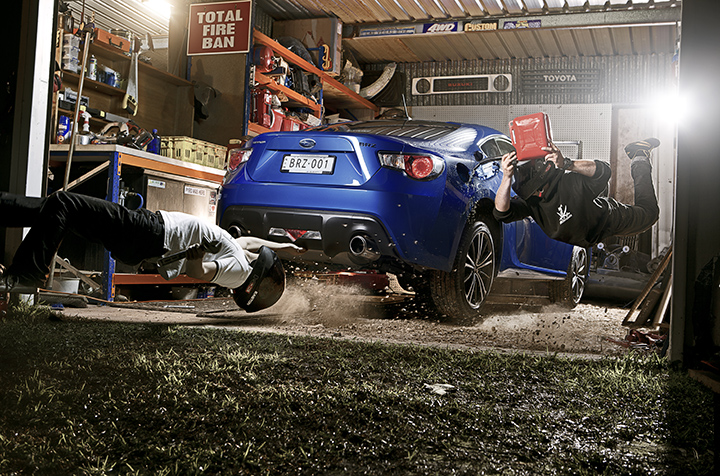
This image comprises around 40 exposures stitched together in post-production. All elements are real and captured in camera. The 'mechanics' were propped up on milk crates, which were later removed in post. Canon EOS 5D Mark III, 24-70mm f2.8, 1/125s @ f6.3, ISO 100.













